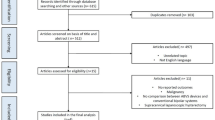Abstract
Objective
To compare operating time and blood loss in patients undergoing total laparoscopic hysterectomies (TLH) for benign conditions with either the Marseal™ IQ 5 mm (MS) or the Ligasure™ 5 mm (LS) vessel-sealing device.
Design and setting
A randomized controlled clinical trial (RCT) in two German gynecology departments.
Patients
74 patients scheduled to undergo TLH for a symptomatic fibroid uterus, adenomyosis or severe meno-metrorrhagia.
Interventions
Patients were randomized to receive a TLH with either the MS or the LS device. 27 variables were prospectively collected to address potential confounding issues.
Measurement and main results
Operating time, defined as the time period between the first (round ligament dissection) and the last (uterine vessels sealing) use of the device, estimated and calculated intraoperative blood loss. The mean operating time (95% confidence interval, CI) was 22.7 min (95% CI 17.6–27.7) for LS and 26.4 min (95% CI 20–32.8) for the MS device (p = .89). The estimated intraoperative blood loss was 164 ml (95% CI 110–217) for LS and 160 ml (95% CI 116–203) for the MS device (p = .36). The multivariate analyses accounting for BMI, endometriosis, uterine weight and appearance of fibroids did not reveal any significant effect of the type of device used on operating time and estimated blood loss.
Conclusion
In this RCT, both devices provided reliable and effective sealing and dissection. The reusable MS showed non-inferiority against the disposable LS device with regard to operating time and estimated intraoperative blood loss.

Similar content being viewed by others
References
Nieboer TE et al (2009) Surgical approach to hysterectomy for benign gynaecological disease. Cochrane Database Syst Rev:CD003677. https://doi.org/10.1002/14651858.CD003677.pub4
Mäkinen J et al (2001) Morbidity of 10 110 hysterectomies by type of approach. Hum Reprod Oxf Engl 16:1473–1478
Harold KL et al (2003) Comparison of ultrasonic energy, bipolar thermal energy, and vascular clips for the hemostasis of small-, medium-, and large-sized arteries. Surg Endosc 17:1228–1230
Alkatout I, Schollmeyer T, Hawaldar NA, Sharma N, Mettler L (2012) Principles and safety measures of electrosurgery in laparoscopy. JSLS 16:130–139
Massarweh NN, Cosgriff N, Slakey DP (2006) Electrosurgery: history, principles, and current and future uses. J Am Coll Surg 202:520–530
Richter S, Kollmar O, Schilling MK, Pistorius GA, Menger MD (2006) Efficacy and quality of vessel sealing: comparison of a reusable with a disposable device and effects of clamp surface geometry and structure. Surg Endosc 20:890–894
Pietrow PK et al (2005) PlasmaKinetic bipolar vessel sealing: burst pressures and thermal spread in an animal model. J Endourol 19:107–110
Klar M et al (2011) Comparison of a reusable with a disposable vessel-sealing device in a sheep model: efficacy and costs. Fertil Steril 95:795–798
Chow S-C (2011) Sample size calculations for clinical trials. Wiley Interdiscip Rev Comput Stat 3:414–427
Flordal PA (1997) Measurement of blood loss in clinical studies. Eur J Anaesthesiol Suppl 14:35–37
Jacoby VL et al (2009) Nationwide use of laparoscopic hysterectomy compared with abdominal and vaginal approaches. Obstet Gynecol 114:1041–1048
Wright JD et al (2013) Robotically assisted vs laparoscopic hysterectomy among women with benign gynecologic disease. JAMA 309:689–698
Wright JD et al (2012) Comparative effectiveness of robotic versus laparoscopic hysterectomy for endometrial cancer. J Clin Oncol 30:783–791
Author information
Authors and Affiliations
Contributions
Author contributions
HMF: data collection, data accuracy, data management. DD: study concept, data analysis, manuscript writing, manuscript editing. SE: principal surgeon II, data collection, data accuracy, data management. GG: study concept, manuscript editing. WJ: principal surgeon I, manuscript editing. KM: study concept, data analysis, manuscript writing, manuscript editing.
Corresponding author
Ethics declarations
Funding
Institutional funding for this study was provided by KLS Martin.
Conflict of interest
GG and DD receive payments for an annual KLS Martin advisory board meeting. MH, MK, ES and JW declare no conflict of interest.
Research involving human participants
All procedures performed were in accordance with the ethical standards of the institutional and/or national research committee and with the 1964 Helsinki declaration and its later amendments or comparable ethical standards.
Informed consent
Informed consent was obtained from all individual participants included in the study.
Electronic supplementary material
Below is the link to the electronic supplementary material.
Rights and permissions
About this article
Cite this article
Hasanov, M., Denschlag, D., Seemann, E. et al. Bipolar vessel-sealing devices in laparoscopic hysterectomies: a multicenter randomized controlled clinical trial. Arch Gynecol Obstet 297, 409–414 (2018). https://doi.org/10.1007/s00404-017-4599-y
Received:
Accepted:
Published:
Issue Date:
DOI: https://doi.org/10.1007/s00404-017-4599-y




